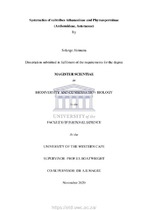| dc.description.abstract | The tribe Anthemideae is a large tribe of the family Asteraceae comprising 111 genera and 1 800 species distributed in Africa, Europe, Asia, and the Northern temperate region, with southern Africa as one of its main centers of diversity, together with Central Asia and the Mediterranean. Ongoing studies have focused on analysing relationships among the southern African subtribes of Anthemideae and the most recent classification recognised fourteen subtribes in which there is a clear biogeographical gradient, with the six southern African subtribes comprising the earliest diverging lineages. The present study focuses on two of these southern African-centred lineages (viz. subtribes Athanasiinae and Phymasperminae). Previous phylogenetic studies of the tribe were based on nuclear nrDNA ITS and plastid cpDNA ndhF sequence data and included only a single representative from each of the genera within the subtribes Athanasiinae and Phymasperminae. The phylogenetic relationships and circumscriptions of the two subtribes have been uncertain and highlighted as being in need of re-assessment, as the monophyly of Athanasiinae is in question and the placement of Phymasperminae differed substantially between nuclear and plastid datasets. The present study aimed at expanding the datasets by including 78 of the 107 (73%) species for these two subtribes based on two nuclear (ITS and ETS) and two plastid (rpl32-trnL and 3’rps16-5’trnK) regions. The resultant nuclear and plastid data were analysed using Maximum Parsimony and Bayesian Inference and the phylogenetic trees used in the reconstruction of morphological characters to assess generic and subtribal relationships of Athanasiinae and Phymasperminae. The phylogenetic analyses of all datasets resolved the previous incongruent position of the subtribe Phymasperminae, consistently recovering the subtribe as sister to Athanasiinae to form a strongly supported monophyletic clade. This relationship between Athanasiinae and Phymasperminae was supported by the following synapomorphies: anthers with polarized endothecial tissues, leaves with secretory cavities and the presence of furanosesquiterpenes. While Phymasperminae could be circumscribed by the cypselas with more than ten ribs and the papillose pericarp, the circumscription of Athanasiinae would be problematic as there were no synapomorphies identified to circumscribe it. Phymasperminae is therefore here subsumed into an expanded Athanasiinae s.l. supported by the anthers with polarized endothecial tissues, leaves with secretory cavities and the presence of furanosesquiterpenes. Generic circumscriptions within the expanded Athanasiinae were also re-assessed and refined based on morphological and phylogenetic data. The circumscription of Phymaspermum Less. is here expanded to include the closely related Gymnopentzia Benth. and Eumorphia DC, while the monotypic genera Asaemia Harv. ex Benth. and Adenoglossa B.Nord. are subsumed within Athanasia L. and Leucoptera B.Nord., respectively. The expanded Phymaspermum s.l. can be recognized by the synapomorphic papillose fruit (either short or long and sometimes also with glandular trichomes) with multiple ribs (10 or more ribs). The previously unplaced genus Inulanthera Källersjö was shown to have a fairly isolated position in all analyses. The nuclear analyses recovered Inulanthera as sister to a broader Athanasiinae - Phymasperminae clade, while in the plastid analyses it was recovered with the Penztiinae - Ursiniinae clade.We therefore describe a new subtribe Inulantherinae S.Akimana, Boatwr. & Magee to accommodate the genus, which can be distinguished from the other subtribes by the tailed anthers, fruits lacking secretory cavities, elongated cells in the ribs and its pappus present as an extension of the cypselas ribs, with each rib extended as a small horn or as a scale. Several taxonomic and nomenclatural changes are implemented here based on the results of the expanded phylogenetic analyses and the morphological reconstructions. New combinations are provided for 9 taxa, two genera are reduced to sectional rank, one new subtribe described and the circumscription of one subtribe expanded. | en_US |

